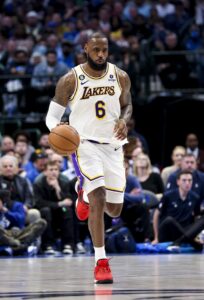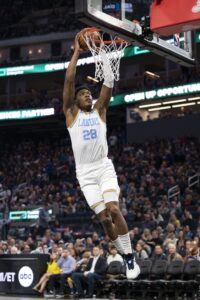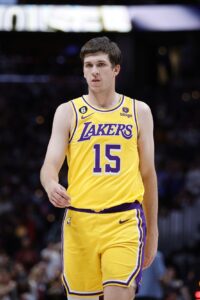Twelve games into the 2022/23 NBA season, the Lakers sat at the very bottom of the league’s standings. Despite relatively good health from Anthony Davis and LeBron James, as well as Russell Westbrook‘s willingness to buy into new head coach Darvin Ham‘s plan to bring him off the bench, L.A. got off to a dismal 2-10 start.
 With the Lakers’ season seemingly headed for disaster, speculation ran rampant. Would the team consider trading Davis? Would James – whose new contract extension made him ineligible to be dealt during the season – ask to be moved in the summer? Would the Lakers’ first-round pick, which the Pelicans controlled in a swap, be used to get Victor Wembanyama to New Orleans?
With the Lakers’ season seemingly headed for disaster, speculation ran rampant. Would the team consider trading Davis? Would James – whose new contract extension made him ineligible to be dealt during the season – ask to be moved in the summer? Would the Lakers’ first-round pick, which the Pelicans controlled in a swap, be used to get Victor Wembanyama to New Orleans?
The Lakers didn’t panic though. They were able to tread water long enough to remain in the playoff hunt at the trade deadline, at which point they exhibited their belief in the Davis/James foundation by making a series of trades to complement that core despite being several games below .500. Westbrook’s $47MM+ expiring contract, a lightly protected 2027 first-round pick, and a handful of second-rounders helped the team land D’Angelo Russell, Malik Beasley, Jarred Vanderbilt, Rui Hachimura, and Mohamed Bamba.
The impact was immediate. Despite missing James for most of March due to a foot injury, the Lakers went 18-8 down the stretch, won their first and only play-in game, then knocked off the No. 2 Grizzlies and defending-champion Warriors to make the Western Conference Finals. They didn’t win a game against the eventual champion Nuggets in that series, but they played Denver as tough as any playoff opponent did, losing those four contests by a total of just 24 points.
With LeBron turning 39 years old in December, there’s still a sense of urgency in Los Angeles to make the most of a title window that could close in a year or two, but the Lakers will at least enter the 2023 offseason having alleviated some of the pressure that led to that Davis- and James-related trade speculation last fall.
The Lakers’ Offseason Plan
When the Lakers acquired Westbrook in 2021, the thinking was that a third star could help ease the burden on Davis and James, take on a greater role if one of those players missed time due to an injury, and perhaps even become AD’s co-star if LeBron decided to call it a career within the next few seasons.
Westbrook wasn’t the right fit, but the logic was sound enough. Two years later, after seeing how poorly the Westbrook experiment went and how well the team played with complementary pieces surrounding their two remaining stars, the Lakers will have a decision to make: Do they try to run it back and stick with the two-star model that worked so well in recent months, or will they look to construct another Big Three, knowing that LeBron’s days in Los Angeles – and in the NBA – could be numbered?
Going the cap-room route in order to create space to sign a star free agent probably isn’t a route the team will take. If the Lakers were to guarantee Vanderbilt’s modest salary for 2023/24, issue a qualifying offer to restricted free agent Austin Reaves, and divest themselves of the rest of their non-guaranteed contracts (including declining options and renouncing free agent cap holds), they could create nearly $28MM in cap room. And they could even push that number a little higher by trading their No. 17 overall pick and/or Max Christie.
 But that still wouldn’t be enough to offer anything close to a maximum-salary contract to a free agent like Kyrie Irving, and it would mean sacrificing some depth — notably, Hachimura couldn’t be re-signed and the mid-level exception couldn’t be used in that scenario. It makes more sense for the Lakers to operate over the cap, retaining the cap holds of Hachimura (another RFA) and Russell, while perhaps also negotiating with other unrestricted free agents like Dennis Schröder.
But that still wouldn’t be enough to offer anything close to a maximum-salary contract to a free agent like Kyrie Irving, and it would mean sacrificing some depth — notably, Hachimura couldn’t be re-signed and the mid-level exception couldn’t be used in that scenario. It makes more sense for the Lakers to operate over the cap, retaining the cap holds of Hachimura (another RFA) and Russell, while perhaps also negotiating with other unrestricted free agents like Dennis Schröder.
That doesn’t necessarily mean the Lakers simply have to bring back the same group. Trading for an impact player who is already under contract isn’t out of the question. If L.A. believes it has a chance to acquire that sort of player, the club could guarantee Bamba’s $10.3MM salary for next season and pick up Beasley’s $16.5MM team option and use those expiring contracts for matching purposes. This year’s No. 17 pick and the Lakers’ 2029 first-rounder could also be dealt.
There are roadblocks in play there though. Star guards like Bradley Beal and Damian Lillard have massive contracts that would require more than just the combined salaries of Beasley and Bamba to match — a sign-and-trade of one of the Lakers’ own free agents would probably be necessary, which would complicate matters. Based on recent reports, L.A. doesn’t appear to be seriously in the mix for Beal anyway, and we don’t know yet whether Lillard will even seek a trade out of Portland.
The Bulls are said to be gauging Zach LaVine‘s value on the trade market, but he’s a subpar defender who is on a massive contract and has no history of postseason success. As good a scorer and shooter as LaVine is, the Lakers may not be eager to upend their roster to land him.
A sign-and-trade for a free agent like Irving or Fred VanVleet wouldn’t be impossible, but it would be challenging, both for salary-matching reasons and because a sign-and-trade acquisition would hard-cap the Lakers at the first tax apron. If they hope to bring back Reaves and Hachimura on market-value deals and sign-and-trade for a top point guard, the Lakers would probably need Irving or VanVleet to accept a team-friendly offer to make it work. Even then, there’s no guarantee Dallas or Toronto would play ball.
The simplest – and seemingly most likely – path for the team this offseason would be to play it relatively safe: Negotiate new long-term contracts with Reaves and Hachimura or match any offer sheets they sign, even if it’s a back-loaded Arenas Provision offer for Reaves; re-sign Russell to a shorter-term deal; use the mid-level exception to re-sign Schröder (who will only have Non-Bird rights) and/or add another player; and keep an eye out for supplemental pieces in free agency who could be willing to sign minimum-salary contracts to play in L.A. for a contender (Chris Paul, maybe?).
The No. 17 pick is also an asset that shouldn’t be overlooked. This Lakers’ front office has a solid history of identifying young talent, having drafted well and found some undrafted gems like Reaves and Alex Caruso. If that pick is retained, it could be used to acquire a young, affordable player who might be able to play regular minutes as a rookie. As a trade chip, it could be packaged with a player on an expiring contract like Bamba or Beasley to bring in a useful veteran on a multiyear deal.
If the Lakers don’t find a trade they like by June 29 involving Beasley or Bamba, I’d probably let Bamba go, but I’d seriously consider picking up Beasley’s option. While Beasley’s price tag is a little higher than you’d hope, his outside shooting is a valuable skill that would be hard to replace on the cheap, whereas the Lakers could probably find a productive enough part-time center for the veteran’s minimum, like they did during the 2022 offseason when they signed Thomas Bryant.
It’s not an easy decision though, especially when factoring in how new contracts for Reaves, Hachimura, and Russell could affect the Lakers’ team salary. Even without Bamba’s salary on the books, there may not be enough room to bring Beasley back and use more than the taxpayer portion of the mid-level exception. Turning down Beasley’s option and trying to re-sign him at a more cap-friendly rate may be prudent, since they’d hold his Bird rights.
As the Lakers showed this past year, a team doesn’t necessarily have to be fully formed out of the gates, given that the in-season trade market offers real opportunities for roster transformations. Rob Pelinka and the front office will certainly explore every avenue to significantly upgrade the rotation this summer in an effort to maximize the final season of LeBron’s 30s (for what it’s worth, I don’t buy that he’s a real threat to retire this summer, but a 2024 exit is conceivable).
However, the team will likely be reluctant to give up any of the important role players that keyed its spring success. If those players are re-signed or otherwise retained and no major additions are made, the Lakers would be in position to be a player again at the 2024 trade deadline if needed.
Salary Cap Situation
Guaranteed Salary
Dead/Retained Salary
Player Options
Team Options
Non-Guaranteed Salary
- Mohamed Bamba ($10,300,000)
- Note: Bamba’s salary would become fully guaranteed if he’s not waived on or before June 29.
- Jarred Vanderbilt ($4,398,000)
- Note: Vanderbilt’s salary would become fully guaranteed if he’s not waived on or before June 30.
- Shaquille Harrison ($2,413,304)
- Total: $17,111,304
Restricted Free Agents
 Rui Hachimura ($7,744,600 qualifying offer / $18,789,564 cap hold): Bird rights
Rui Hachimura ($7,744,600 qualifying offer / $18,789,564 cap hold): Bird rights- Austin Reaves ($2,189,698 qualifying offer / $2,189,698 cap hold): Early Bird rights
- Total (cap holds): $20,979,262
Two-Way Free Agents
Draft Picks
- No. 17 overall pick ($3,640,200)
- No. 47 overall pick (no cap hold)
- Total: $3,640,200
Extension-Eligible Players
- Malik Beasley (veteran)
- Anthony Davis (veteran)
- D’Angelo Russell (veteran)
- Jarred Vanderbilt (veteran)
Note: These are players who are either already eligible for an extension or will become eligible before the 2023/24 season begins. Russell would only be eligible until June 30.
Unrestricted Free Agents / Other Cap Holds
- D’Angelo Russell ($40,200,000 cap hold): Bird rights
- Lonnie Walker ($7,774,800 cap hold): Non-Bird rights
- Troy Brown ($1,989,698 cap hold): Non-Bird rights
- Wenyen Gabriel ($1,989,698 cap hold): Early Bird rights
- Dennis Schröder ($1,989,698 cap hold): Non-Bird rights
- Tristan Thompson ($1,989,698 cap hold): Non-Bird rights
- Carmelo Anthony ($1,989,698 cap hold): Non-Bird rights
- Avery Bradley ($1,989,698 cap hold): Non-Bird rights
- Jared Dudley ($1,989,698 cap hold): Early Bird rights
- Wayne Ellington ($1,989,698 cap hold): Non-Bird rights
- Dwight Howard ($1,989,698 cap hold): Non-Bird rights
- Dion Waiters ($1,989,698 cap hold): Non-Bird rights
- Mason Jones ($1,774,999 cap hold): Non-Bird rights
- Total: $69,646,779
Note: The cap holds for the players listed in italics remain on the Lakers’ books from prior seasons because they haven’t been renounced. They can’t be used in a sign-and-trade deal.
Cap Exceptions Available
- Mid-level exception: $12,220,600
- Bi-annual exception: $4,448,000
- Trade exception: $2,700,000
- Trade exception: $2,298,385
- Trade exception: $1,836,090
- Trade exception: $1,836,090
Note: The Lakers would lose access to the full mid-level exception and the bi-annual exception if their team salary surpasses the tax apron. If the Lakers go under the cap to use room, they’ll lose access to all of these exceptions and will gain access to the room exception.
 With the Lakers’ season seemingly headed for disaster, speculation ran rampant. Would the team consider trading Davis? Would James – whose new contract extension made him ineligible to be dealt during the season – ask to be moved in the summer? Would the Lakers’ first-round pick, which the Pelicans controlled in a swap, be used to get
With the Lakers’ season seemingly headed for disaster, speculation ran rampant. Would the team consider trading Davis? Would James – whose new contract extension made him ineligible to be dealt during the season – ask to be moved in the summer? Would the Lakers’ first-round pick, which the Pelicans controlled in a swap, be used to get  But that still wouldn’t be enough to offer anything close to a maximum-salary contract to a free agent like
But that still wouldn’t be enough to offer anything close to a maximum-salary contract to a free agent like 